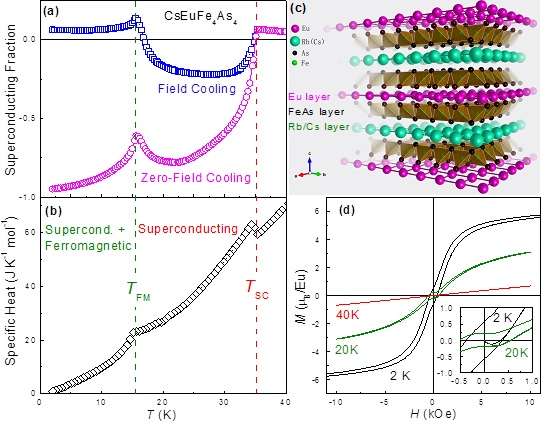New ferromagnetic superconductor—CsEuFe4As4

Superconductivity (SC) and ferromagnetism (FM) are mutually antagonistic collective phenomena in solids. Macroscopically, a superconductor expels magnetic fluxes from its interior below the superconducting critical temperature TSC. By contrast, a ferromagnet magnetizes itself (for a single magnetic domain) spontaneously below the ferromagnetic transition temperature TFM. Although SC and FM are incompatible in most cases, there is still the possibility of their coexistence, which, since the 1950s, has become a long-standing issue for scientists who work in the field of superconductivity. Since the late 1970s, a few material systems called "magnetic superconductors" have been considered as the candidates of ferromagnetic superconductors (FMSC). However, bulk SC and full FM were rarely observed simultaneously.
One of the iron-based superconductors, P-doped EuFe4As4, shows evidence of both SC and FM. However, the specific heat jump at TSC (which demonstrates bulk SC) is not obvious. Furthermore, the details of ferromagnetism are still debated. Very recently, researchers in Zhejiang University succeeded in replacing every alternate Eu layer by a non-magnetic Rb/Cs layer, yielding twin compounds RbEuFe4As4 and CsEuFe4As4 (see the upper-right panel of Fig. 1). In the twin materials, researchers observed both bulk superconductivity and full ferromagnetism simultaneously.
Fig. 1(a) and 1(b) are the temperature dependence of direct-current magnetic susceptibility and specific heat, respectively, for sister compound CsEuFe4As4. The two transitions at TFM = 15.5 K and TSC =35.2 K can be clearly seen. In general, the DC magnetic susceptibility at a small magnetic field is a measure of superconducting volume fraction. One sees that the superconducting magnetic-shielding fraction, represented by the zero-field cooling data, is almost 100 percent at the lowest temperature. This indicates bulk SC, which is further confirmed by the obvious specific-heat jump at TSC. Surprisingly, the field-cooling data lose the diamagnetism below TFM, which is due to the Eu-spin ferromagnetic ordering that is demonstrated by the field-dependent magnetization shown in Fig. 1(d). Note that SC persists at the low temperature region, as seen by the initial magnetization (see the inset) as well as the non-convergence of magnetization at high fields at 2 K. The researchers also notice that there is no specific heat jump (only a kink instead) at TFM. They point out that it is a rare third-order ferromagnetic transition that has not been experimentally found up to date.
The observation of robust SC and FM in (Rb/Cs)EuFe4As4 strongly suggests that the expected mutual suppression between SC and FM can be minimized via a certain mechanism, which may shed light on the mechanism of iron-based SC, as the team leader Guang-Han Cao said. These authors also address the intriguing issue of how SC can coexist with FM.
More information: Yi Liu et al, A new ferromagnetic superconductor: CsEuFe4As4, Science Bulletin (2016). DOI: 10.1007/s11434-016-1139-2
Provided by Science China Press




















